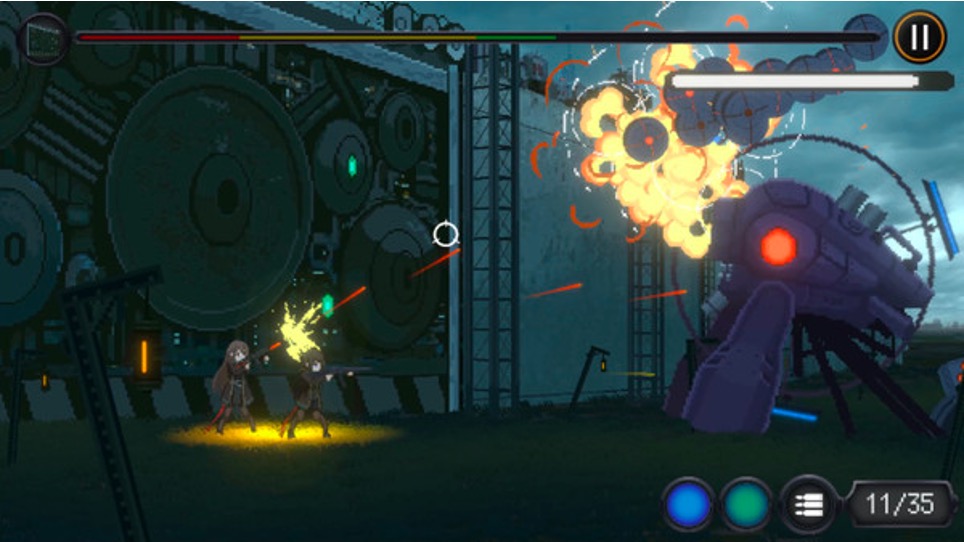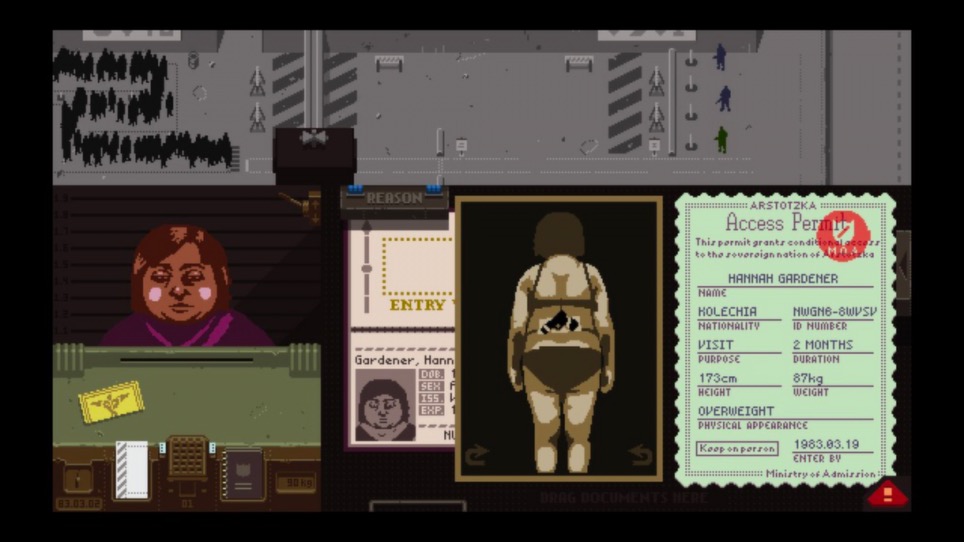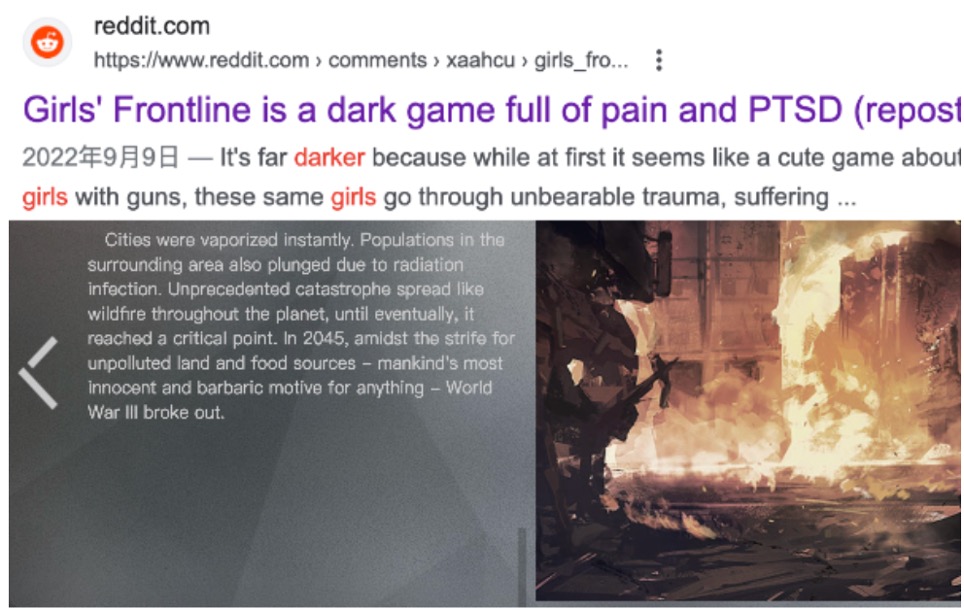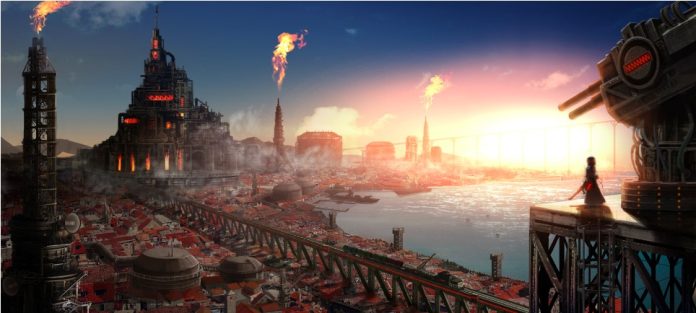The rise of indie game Marfusha as a part of exported Chinese soft power
Quick-paced shooting, characters drawn in pixel anime style, and the dark, grey skyline of a dystopian atomic punk city.
This is Marfusha, a new game released on Nintendo Switch in April this year. Hosted on PC’s Steam platform in 2021, Marfusha has now fully supported PS5, Xbox One and Nintendo Switch as a stick-control game, and has not yet been reviewed by IGN.(formerly known as Imagine Games Network).
Marfusha is basically girls shooting robots meets with Papers Please’s mechanics. Its play mechanics are simple: move your mouse or stick to shoot in a two-dimensional platform; the goal is to prevent invading robots from breaching the wall. The gameplay mechanism is also easy to understand: the player defeats waves of the enemy, uses a slot machine to buy new equipment, upgrades or companions, and tries to survive until day 100. However, the player is introduced to a dystopian environment where a girl is recruited into the militia to fight for a totalitarian state against invading robots of another country – while paying hefty taxes.
Success as an indie project
Dubbed “Molten metal Marfusha” in the original Japanese production, the game had a humble beginning as a small indie project created by the online artist hinyari9. In a Japanese website Gamespark game&anime review, hinyari9 reveals this was the first time he tried to create a game and took a three-month Unity course to gain the necessary skills.
Contrary to his plan to create a simple, short-length game first and then work on a larger project – which he planned to improve based on the reception of the first game – he was surprised at the wide-reaching immediate popularity of his first effort. Marfusha achieved a high rating on Steam and attracted business cooperation opportunities. Eventually, he cooperated with PLAYISM to get a console version published with anime trailers.
This can be attributed to three factors: the gameplay alacrity, the well-drawn art style, and the darkness of its background setting. These contribute to a gameplay experience arguably similar to Papers Please, “but it’s anime girls shooting robots”.
Shooting gallery
In reviews on the English Internet, enthusiasts say the game has a short, tight playthrough of approximately two hours but offers a fast-paced combat procedure during those hours. There are 100 attack waves. During each wave, around 10 seconds to one minute each, the player faces actual stress in dealing with many enemies, either fending off the horde or being overrun in a minute. In shooter video games, the player does not require complex gaming skills or fast reaction capacity to defeat the enemy: just keep pressing the trigger while aiming horizontally to target enemies on land or in the air.

However, it would be difficult to fend off enemies if the player does not purchase wisely in every after-turn slot machine shop. A hidden logic of randomness and strategic management is at play here: the player accumulates funds to upgrade or buy new weapons, and one-time-use map clearers, hire companions and set up barricades. The randomness of this Gacha mechanism requires the player to think wisely about their next step to survive the next, perhaps unpredictable, wave in which enemies range from cannon fodder to giant bullet hell behemoths. Performance in each wave influences the player’s income; players who behave poorly in any wave risk finding themselves in deficit and face a looming game over.
The game mechanism works in a similar way to the successful indie game Papers, Please, which itself is a successful narrative game aimed at simulating border inspector. It would be easy for players to complete the simplified game process and redo playthroughs, but it would not be a light-hearted journey alone.

Influence of Chinese soft power aesthetic: Gun Girls and Dystopia
On the Japanese Internet, commentators from Gamespark point out that the success of Marfusha might be related to its well-performed art and world setting.
In the game, the player controls “Marfusha”, a humble girl working as a baker while raising a sister who was drafted. If Marfusha performs unsatisfactorily, she risks being sent to a labour camp and possibly die. Many colourful characters assist the player during the campaign; all effort is made to make these characters human and attractive, and they usually die with Marfusha in the relentless enemy waves.
There are no good guys in the story; the enemy country fighting against the totalitarian state has human rights for the masters only, while prisoners of war are transformed into mindless robot slaves. The only “good ending” allows Marfusha to continue the extended draft, become blind in one eye but finally meet her sister and go forth into an uncertain future.
The game artwork resembles a bizarre mix of cute anime pixel art and gloomy backgrounds, like giant industrial cities and Khrushchevka-style slums. There are no fancy hi-tech weapons but a relatively modest transistor-punk grim style of fictional weapons. The characters are primarily dressed in dark clothing, with a distinctive melancholy on a pretty face. Finally, settings for the girls are also noticeably “Eastern European” in nature: Marfusha refers to “little Marsha”, and Belka, Strelka and Laica are also heavily themed in Eastern European fashion.
These features are, according to hinyari9, not his design; he has drawn inspiration from his favourite mobile game, Girls Frontline, which is a Chinese mobile strategy game developed by the MICA team in 2016. In this game players control echelons of android characters, known in-universe as T-Dolls, each carrying a specific real-world firearm. The game is a substantial commercial success beyond China, and ranked in the top three of South Korea’s mobile game market in 2017. Even Airasia decides to collaborate and paint an airbus into a Girl’s Frontline theme livery.
Take a look at @AirAsia X’s special Girls Frontline livery visiting Taoyuan Airport in the evening. @GirlsFrontline #taoyuanairport pic.twitter.com/8BZAqISg1X
— Taoyuan Airport (@taoyuanairport) August 14, 2018
Girls’ Frontline’s success is due to its unique aesthetic that can merge the anime’s trope and a darker world setting in which characters can get hurt and perish on the battlefield. The inspiration comes from post-Soviet nostalgia, as the story is set in Eastern Europe with East Germany rising against Reunified Germany. The player is employed in a PMC that works under the Neo-Soviet authority akin to today’s Wagner group.
These settings are in many ways unique and alluring , for no other anime mobile games have drawn their stories in a dark, dystopian tone. Marfusha, in all its regards of art style settings and story, draws heavy inspiration from Girls’ Frontline, almost being a fan work of the Girl’s Frontline franchise.

Furthermore, the influence of Chinese soft power is far from over: so far, Marfusha’s success leads to a collaborating with another mobile game – Ash Front– created by a Chinese team but published in the Japanese market first.
Indie game creators can learn from Marfusha’s recipe that a unique art style and combination of popular genres are a good idea, should they truly grasp the core aesthetic in both illustration and storytelling. Developers may also try to expand their scope when creating anime genre games to gain inspiration from works beyond Japan and deconstruct the stereotypical genre of anime games.
Overall, the game provides the player with a fun experience and is suitable for players who are interested in having fun but have limited time. It is worth the relatively cheap price (USD 11.99$).


